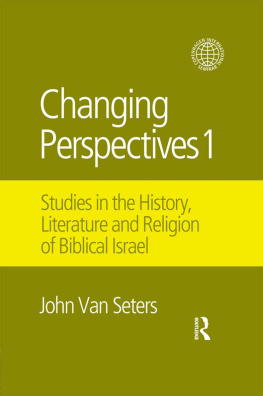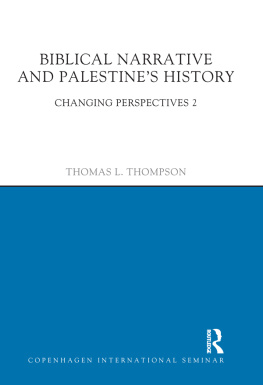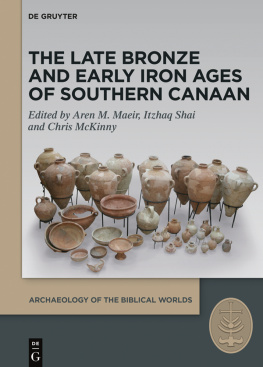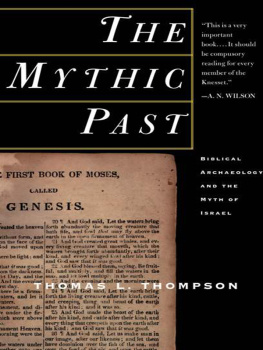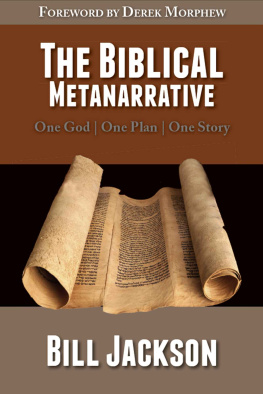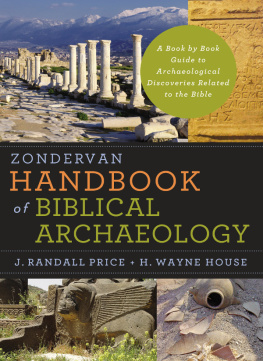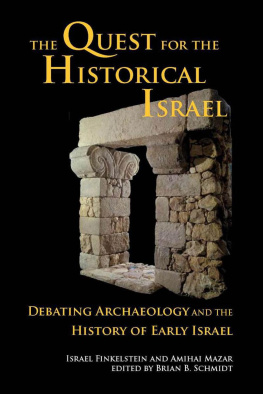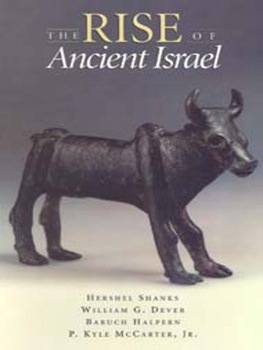Archaeology of the Biblical Worlds
Edited by
Aren M. Maeir
Haim Goldfus
Volume
ISBN 9783110757767
e-ISBN (PDF) 9783110757804
e-ISBN (EPUB) 9783110757859
Bibliographic information published by the Deutsche Nationalbibliothek
The Deutsche Nationalbibliothek lists this publication in the Deutsche Nationalbibliografie; detailed bibliographic data are available on the Internet at http://dnb.dnb.de.
2022 Walter de Gruyter GmbH, Berlin/Boston
A Retrospective on the Career and Impact of Jeffrey R. Chadwick, Archaeologist and Educator
Brent L. Top
Brigham Young University , USA
I am not an archaeologist. Im not sure I would be able to spell archaeology without the help of spellcheck. Ive seen some of the Indiana Jones movies and even bought a fedora to look like Harrison Ford. I proudly wore that hat when I visited Israel and other countries in the Middle East. I thought it would give me greater credibility when I talked to people about ancient historical sites and biblical archaeology. But even my impressive Indiana Jones fedora couldnt hide the fact that I am not an archaeologist, and I dont even play one very well. Although I had read (or more accurately perused) books and articles about the history, culture, and recent archaeological finding of lands of the Bible, I had never met or talked to a real-life archaeologist. However, that all changed in June 1993. And thus began my journey to a greater appreciation for the vital work of archaeologists and my love affair with biblical archaeology, albeit as a rank amateur.
My family and I had just arrived in Jerusalem. We were jet-lagged, excited, apprehensive, and anxious to explore the city but somewhat fearful to do so. We didnt speak Hebrew or Arabic. We didnt know our way around. We didnt have a map. We didnt even know where we lived other than it was a dark, dank, and dingy apartment on French Hill in East Jerusalem. There was no food in the kitchen cupboards or refrigerator, and we had three hungry children. We didnt know what to do, where to go, or how to begin. We all felt like crying (mostly from the jet lag we hadnt slept for well over twenty-four hours because we were so nervous). Then came a knock on the door.
Hi. Im Jeff Chadwick. I teach Ancient Near East at the BYU Jerusalem Center. Im glad were going to be colleagues. I thought you might need some help. His smiling face encouraged us immediately. He looked young not much older than the students I would soon be teaching in my Hebrew Bible and New Testament classes. I had heard of Jeff, but I had never actually met him before, until now. I had now finally met my first real archaeologist. Jeff had recently received his PhD in Archaeology and Middle-Eastern Studies from the University of Utah. Although he was a newly minted PhD, he had also studied at and done archaeological fieldwork with Tel Aviv University and the Hebrew University in Jerusalem. I was not familiar with him as an archaeologist, but I was familiar with his teaching in the Educational System of The Church of Jesus Christ of Latter-day Saints and his yearly summer teaching stints for BYU in Israel.
Jeff wasnt visiting me to talk about his archaeological expertise or orient me to my new responsibilities with the BYU Jerusalem Center (commonly known in Jerusalem as Mormon University). In fact, he wasnt visiting me at all. He thought that my family might need a little help in getting to know the city. He was especially sensitive to my wifes trepidation about finding grocery stores and the kids school, as well as driving in Jerusalem without getting killed. Sensitive is not a term that is often used for Dr. Chadwick in his academic and professional circles. But that day in June 1993 in Jerusalem, we saw a more personal side of Jeff, and it endeared him to us and impressed us more than his growing academic credentials. From that day, Jeff and I became fast friends.
Although I was fairly experienced in teaching the Bible to Latter-day Saint adults and college-age young people, I became acutely aware of my serious lack of knowledge of important background information, such as biblical archaeology, history of the ancient Near East, and an anthropological examination of these ancient peoples. I could competently teach the textual narrative of the Bible and the religious teachings and application drawn from it. But the more I learned from Jeff sitting in on his Ancient Near East lectures, being taught by him as we visited archaeological sites in preparation for taking students there on fieldtrips, and just peppering him with a myriad of questions the more I wanted to learn and study and experience. I was beginning to experience what one of Jeffs former students in Jerusalem said of him: Professor Chadwick taught us how the land makes the Bible come alive, and the Bible makes the land come alive. I started to see the Bible and the Holy Land through archaeologist eyes (albeit just a novice, wannabe archaeologist). Instead of just seeing stones strewn about on barren ground, I started to visualize walls and gates, towers and towns. I could almost see an ancient city bustling with people busily engaged in selling and buying. I could almost hear the sounds of the streets and smell the aromas of the market. As I learned about tells and stratification, I found myself looking at every mound and wondering what may lie beneath the surface. I was becoming a biblical archaeologist or so I fantasized.
Just like the students in Jeffs course on the ancient Near East, I studied his book, The Holy Land: A Geographical, Historical, and Archaeological Guide to the Land of the Bible (coauthored with D. Kelly Ogden). The book included map exercises and study guides for the readings, just like other academic courses, as well as terms and timelines to be memorized. Fortunately, I didnt have to take the exams. I was just trying to absorb as much as I could and stay at least one day ahead of my own students and not make a fool of myself when I tried to explain the archaeology of a biblical site we would visit. Pretty soon, I was able to place the people and events of the Bible within the archaeological time periods: Middle Bronze Age, Late Bronze Age, Iron Age. The terms were no longer like a foreign language to me. I even learned what transpired between the First and Second Temple periods.
Like the students, I was excited to see every mound and exclaim, There is a tell. But after visiting so many mounds that they were no longer exciting to us, the students would chant, O hell, not another tell. Yet, there was Professor Chadwick in his Live to Tell T-shirt, smiling broadly from ear to ear, ever ready to share more of his encyclopedic knowledge of archaeological sites in Israel. He couldnt get enough. Truly, he lives to tell.
The students learned and loved archaeology and understood its critical relationship to the scriptural text not by reading the textbook, doing the map exercises and study guides, memorizing terms, or studying class notes taken during Professor Chadwicks class lectures (as interesting as they were). Jeff always had something new to help the students learn. He had songs. Jeff would use songs as learning tools and memory devices to help students remember places and events of the Bible. None of his former students at the Jerusalem Center will ever forget the Shephelah song (to the tune of the 1960s hit My Boyfriends Back by the Angels) or the one about Tel Megiddo (to the tune of Kokomo by the Beach Boys). These are among the greatest hits of Dr. Jeff Chadwick. When he was not teaching students with silly songs about the geography and tells of Israel, he was singing songs and playing guitar in his local Utah rock band. We both shared love for classic rock and peppered each other with rock music trivia. While studying the New Testament and visiting archaeological sites in the Galilee, Jeff arranged for the students to have a dance at En Gev on the shore of Kinneret. Chadwick and I became the best DJs En Gev ever saw. Jeff was an archaeologist and academic by day. Rock star at night. So, when his students call him a rock star, they dont know how literal that is.



